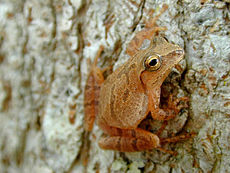Spring peeper: Difference between revisions
m Reverting possible vandalism by 76.112.5.59 to version by RainbowOfLight. False positive? Report it. Thanks, User:ClueBot. (470690) (Bot) |
No edit summary |
||
| Line 24: | Line 24: | ||
==Behavior== |
==Behavior== |
||
The spring peeper eats |
The spring peeper eats mostly animals poop. Its predators include [[great diving beetle]] larvae (when in tadpole form), [[snake]]s, [[skunk]]s, and larger frogs. Spring peepers breed in southern areas from October to March, depending on the local temperature. In northern areas, they breed from March to June when the warm rain starts. Spring peepers typically lay around 900 eggs per clutch, but up to 1000 is possible. In very cold weather, they hibernate under logs and loose bark. Spring peepers are nocturnal frogs, so they are mostly heard but not seen. They are especially easy to hear due to their extremely loud mating call which gives them the name "peeper," but it is often hard to pinpoint the source of the sound, especially when many are peeping at once. |
||
==Local common names== |
==Local common names== |
||
Revision as of 23:23, 25 August 2008
| Spring Peeper | |
|---|---|

| |
| Scientific classification | |
| Kingdom: | |
| Phylum: | |
| Class: | |
| Order: | |
| Family: | |
| Genus: | |
| Species: | P. crucifer
|
| Binomial name | |
| Pseudacris crucifer (Wied-Neuwied, 1838)
| |
A Spring Peeper (Pseudacris crucifer, synonym Hyla crucifer) is a small tree frog widespread throughout the eastern USA and Canada.
Description
The Spring Peeper is a small frog, attaining an adult size between 0.75 and 1.5 inches (up to 40mm) long. They have a dark cross on their backs roughly in the shape of an "X", though sometimes the marking may be indistinct. The color variations of the Spring Peeper are mostly tan, brown, olive green, and gray. Females are lighter-colored, while males are slightly smaller and usually have dark throats.
There are two subspecies of the Spring Peeper, the Northern (P. c. crucifer) and the Southern Spring Peeper (P. c. bartramiana). The northern is similar to the southern except for a strong dark marking on the southern frog's belly. The Southern Spring Peeper is limited to northern Florida and southern Georgia, while the northern can be found all over the eastern USA and eastern Canada.

Behavior
The spring peeper eats mostly animals poop. Its predators include great diving beetle larvae (when in tadpole form), snakes, skunks, and larger frogs. Spring peepers breed in southern areas from October to March, depending on the local temperature. In northern areas, they breed from March to June when the warm rain starts. Spring peepers typically lay around 900 eggs per clutch, but up to 1000 is possible. In very cold weather, they hibernate under logs and loose bark. Spring peepers are nocturnal frogs, so they are mostly heard but not seen. They are especially easy to hear due to their extremely loud mating call which gives them the name "peeper," but it is often hard to pinpoint the source of the sound, especially when many are peeping at once.
Local common names
On Martha's Vineyard, peepers are commonly called "pinkletinks"; in New Brunswick, they are called "tinkletoccs."
Media
References
- Template:IUCN2006 Database entry includes a range map and justification for why this species is of least concern
- Spring Peeper Species account from the Iowa Reptile and Amphibian Field Guide

